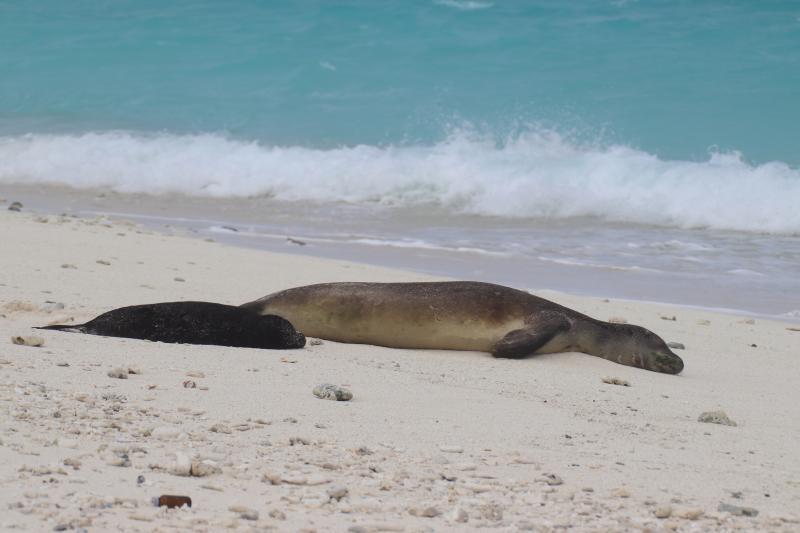
From past patients to new moms
by NOAA Fisheries 27 Sep 2024 20:47 UTC

LL00 and her first pup lay on the sands of Holaniku © Kure Atoll Conservancy (Permit #22677-02)
Two Hawaiian monk seals who were previously rescued and rehabilitated are now new mothers!
During annual summer Hawaiian monk seal monitoring and assessment field camps in the Papahanaumokuakea Marine National Monument, researchers work to support seal protection and recovery. In addition to tagging pups, counting seals, gathering observational data, and much more, they also provide life-saving interventions to increase seal survival. We confirmed two Hawaiian monk seals, who were rescued by NOAA staff and rehabilitated years ago, are now first-time moms!
Successfully rescuing and caring for injured seals requires a collective effort with many dedicated partners and resources. The rehabilitation of injured Hawaiian monk seals is a key part of population recovery and each seal pup born brings us closer to achieving that.
The monk seals were originally rehabilitated at The Marine Mammal Center’s monk seal hospital, Ke Kai Ola, on Hawai'i Island. The Hawai‘i Department of Land and Natural Resources, working in partnership with Kure Atoll Conservancy, alerted us to this great news. TF90 and LL00 were reported nursing healthy pups at Holaniku (Kure Atoll) in April and have since successfully weaned their pups. These are the first recorded births for both seals and are all thanks to massive efforts to care for them when they were young and malnourished.
TF90's Story
TF90, also known as Pua 'Ena O Ke Kai, was born in 2014 and rescued when she was only a few months old. She was successfully rehabilitated and released in 2015. Today, she is 10 years old and her story highlights the power of partnership and coordination.
At that time, NOAA Fisheries Marine Biologist Hope Ronco was deployed to Kamole (Laysan Island) as part of a three-person team studying Hawaiian monk seals. She recalls the coordinated effort it took to rescue Pua. After monitoring Pua and documenting her declining body condition, they received permission to place her in a shorepen for a full evaluation. "We searched and searched, and of course finally found Pua in the early evening at one of the farthest areas from camp on the southern end of the island in an area known as shipwreck. We successfully captured Pua in a stretcher net and carried her more than 1 mile back to our camp," Hope recalled. "While the average healthy weaned pup weighs around 150 pounds, TF90 was only 50 pounds at the time, yet it was still an effort to carry her that far."
The team arrived exhausted, but thrilled to successfully place her into a secure pen. They monitored her closely; a veterinary team determined that she would be an excellent candidate for rehabilitation. Pua was placed on the team's research vessel for transportation to Ke Kai Ola, and the team continued to care for Pua while in transit.
Once Pua made a full recovery, more partners joined in on the effort to return her home. Pua joined a U.S. Coast Guard flight to Kuaihelani (Midway Atoll). Here she was held for a few days before being transported by ship to Holaniku during a routine U.S. Fish and Wildlife Service and Hawai'i Department of Land and Natural Resources and Kure Atoll Conservancy resupply mission. NOAA staff recalls the TF90 and other returning seals' curiosity and excitement playing in the sand.
LL00's Story
In 2019, LL00, also known as Maka Kilo, was rescued on Kapou (Lisianski Island). She was malnourished and would not have survived without direct intervention. In the days leading up to their pick up and departure on the NOAA Ship Oscar Elton Sette, the field team could not find LL00. At the last possible moment, she hauled out on the beach and the team guided her into a cage and got her onto the Oscar Elton Sette. She was transported to Ke Kai Ola for some much-needed rehabilitation.
LL00 was closely monitored and cared for by Hawaiian monk seal hospital's expert team, which included being tube fed a fish-mash smoothie three times a day. After 10 months of rehabilitation, LL00 weighed about 200 pounds and was ready to return home. Summer field camps were canceled in 2020 and her release required extra organization. The U.S. Coast Guard flight to Kuaihelani flew LL00 to Kuaihelani. She was held in a pen on a beach for a few days while being monitored by U.S. Fish and Wildlife Service staff before being released. Her care, transport, and release was a massive undertaking and a great example of the interagency coordination needed to support these special animals.
The Impact of Rehabilitation Efforts
"For an endangered species, every patient matters," says Dr. Sophie Whoriskey, Associate Director of Hawai?i Conservation Medicine at The Marine Mammal Center. "To hear the incredible news that former patients Pua 'Ena O Ke Kai (TF90) and Maka Kilo (LL00) are nursing healthy Hawaiian monk seal pups is a powerful example of the impact of conservation efforts by NOAA and programs like ours."
In the time following their return to the Papahanaumokuakea Marine National Monument, these seals were observed to be in good condition. LL00 even made a whole 60-mile swim from Kuaihelani to Holaniku! These new mothers and their pups represent the importance of Hawaiian monk seal rescue and rehabilitation. We celebrate them and the many organizations whose commitment to this endangered species make progress in their recovery possible.